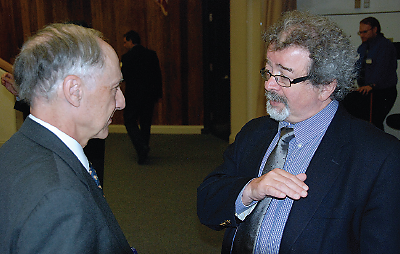Context is Critical in PTSD Fear Learning
Abstract
The workings of the amygdala explain some of the symptoms of posttraumatic stress disorder, but understanding others requires attention elsewhere in the brain.
The amygdala was one of the earliest brain regions marked for investigation in posttraumatic stress disorder (PTSD) because imaging showed increased activation there when subjects were exposed to trauma-related stimuli, said Israel Liberzon, M.D., a professor of psychiatry, psychology, and neuroscience at the University of Michigan.

Robert Ursano, M.D. (left), chair of psychiatry at the Uniformed Services University of the Health Sciences, talks at the Eighth Annual Amygdala Conference with Israel Liberzon, M.D., a professor of psychiatry, psychology, and neuroscience at the University of Michigan.
But what exactly is the role of the amygdala in PTSD? For one thing, a hyperactive amygdala inadequately regulated by the medial prefrontal cortex (mPFC) might explain the exaggerated psychophysiological reactivity and emotional responses to trauma stimuli seen in patients with PTSD, he noted.
“But we did not believe that this was the full story,” Liberzon said at the Eighth Annual Amygdala Conference held recently at the Uniformed Services University of the Health Sciences in Bethesda, Md. “The amygdala is not a memory site and cannot explain intrusive symptoms, hypervigilance, and emotional numbing.”
The amygdala is highly associated with visual and auditory stimuli, he said. It serves as an alert system but is not specific to fear and can respond to positive inputs too.
“If PTSD is the result of an actual event, then we must look at learning and memory,” said Liberzon. “If the conditioned memory of fear is stronger than the extinction memory, then either you have enhanced conditioning or diminished extinction.”
Studies in rodents using a single prolonged stress model that combined extended restraint, forced swimming, and ether exposure showed enhanced negative feedback of the HPA axis and exaggerated startle. These animals demonstrated normal fear conditioning and extinction but altered fear renewal in contextual exposure.
“There also appears to be an increase in glutaminergic receptors in the locus ceruleus and decreased glutaminergic signal in the mPFC,” he said.
The hippocampus is involved in memory and is abnormal in those with PTSD. Studies of monozygotic twin pairs have found that both the twin exposed to trauma and who had PTSD and the unexposed twin had smaller hippocampal volumes.
“So perhaps a smaller hippocampal volume predisposes someone to PTSD [upon exposure to trauma],” he said. “Maybe the problem in PTSD isn’t the fear response system but is rather the process that is supposed to modulate the fear response system.”
Context, modulated by the hippocampal and prefrontal regions, could actually explain a lot of PTSD symptomatology, he suggested. Context doesn’t necessarily define the fear response, but it defines when the fear response kicks in.
“If fear response kicks in inappropriately, or if you cannot put it in a cognitive context, you can develop multiple symptoms,” said Liberzon. “You can become hypervigilant because the context is not right and you start scanning for the threats.”
In those instances, PTSD patients fail to perceive both new threats and safety cues accurately. Control subjects exposed to combat but who did not develop PTSD have more activation to new threats and a normal renewal of fear, but this is not the case with PTSD patients because of their inability to perceive both safety contexts and new threat contexts, he said.
Deficient contextual processing could lead to intrusive symptoms and hypervigilance triggered by contextual cues, traumatic reexperiencing, emotional numbing, and retraumatization.
“Deficits in contextual processing in PTSD patients could contribute to the maintenance of fear memories and PTSD symptomatology, as well as abnormal fear learning of novel stimuli,” he said. ■



